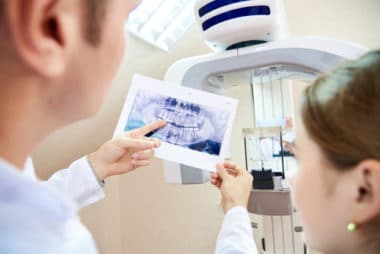Dental X-Rays in Buffalo, NY
Todd Shatkin DDS is an experienced Buffalo dentist providing affordable dental x-rays to patients in Amherst, Williamsville, Clarence, Buffalo, Western New York, the United States and Internationally. Dr. Shatkin utilizes the latest technology to provide minimally invasive treatments and more accurate diagnoses. Contact Aesthetic Associates Centre today to arrange your free consultation and get your dental x-rays.
Dental x-rays are an essential part of any dental practice as they allow the dentist to see things that they can’t with a simple visual examination. X-ray technology allows dentists to see and treat dental problems before they become serious. Newer technology and the development of dental cone beam computed tomography (CBCT) allow dentists to take x-ray imaging one step further and deliver a three-dimensional image of your dental structure, soft tissues, nerve paths, and bone, allowing for more precise treatment planning.
What Do Traditional Dental X-Rays Show?
 Traditional dental x-rays give the dentist the ability to look inside your teeth, the tip of the roots and underneath your gums. This area is not visible to the naked eye, so this gives the dentist a better idea of what is going on inside your mouth. In the dental office, you may receive bitewing, periapical, and panoramic dental x-rays.
Traditional dental x-rays give the dentist the ability to look inside your teeth, the tip of the roots and underneath your gums. This area is not visible to the naked eye, so this gives the dentist a better idea of what is going on inside your mouth. In the dental office, you may receive bitewing, periapical, and panoramic dental x-rays.
Bitewings show the crown portion of the teeth and allow the dentist to check for early signs of decay. Periapical dental x-rays look at the bone height and root tips of the teeth. A panoramic dental x-ray creates an image of the entire oral cavity and this can help identify things like impactions, cysts, tumors, jaw disorders, or bone irregularities.
Depending on your dentist and your need for care, other x-rays, such as occlusal x-rays, help a dentist evaluate tooth growth in children, while cephalometric x-rays help orthodontists plan orthodontic treatments.
What is Cone Beam Computer Tomography (CBCT)?
Dental Cone Beam Computer Tomography, or CBCT, is a specialized type of x-ray machine that utilizes technology designed to create a three-dimensional image of your craniofacial region in a single scan. This is a painless and noninvasive procedure that provides a highly accurate diagnostic tool. During a CPCT, an x-ray beam in the shape of a cone moves around the patient with a complete 360-degree rotation, taking a large number of images. In a single rotation, the CBCT is able to generate hundreds of high-resolution images that are then combines to form a 3-D image. These detailed images provide the dentist with a more detailed picture of what is going on. The procedure is quick and only takes between 20 and 40 seconds.
This technology gives the dentist an advantage when it comes to creating a precise treatment plan catered directly to your needs. This technology is commonly used now in orthodontic treatment planning but can be essential in complex dental cases such as severely impacted teeth, accurate dental implant placement, evaluating jaw, sinus, and naval cavity issues, diagnosing temporomandibular joint disorder (TMJ), and much more. If you are interested in dental x-rays, contact Dr. Todd Shatkin today for a free consultation.
How Do You Benefit from Cone Beam CT?
CBCT is an incredible technological advancement that gives our dentists a powerful diagnostic tool. With a single scan, your dentist is able to get a much more precise picture of your oral health and teeth structure. The 3D imaging allows the dentist to better see any potential problems and better create a treatment plan for you.
Are Dental X-Ray’s Safe?
Dental x-rays and CBCTs used in dental offices emit small doses of radiation, but our office takes every precaution to reduce your risk of increased exposure. Dental x-rays are only taken when they are diagnostically necessary. You will have a lead full-body apron in place before any x-ray procedure to minimize exposure.
How Often Should You Have Dental X-rays?
Traditional dental x-rays are typically preformed at an initial dental visit. Depending on your oral health and dental needs, additional dental x-rays may be necessary as treatment plans progress.
Children and teens with a history of cavities or those that are experiencing tooth development abnormalities may require additional dental x-rays as often as every six months in order to evaluate oral health and track development. Adults with extensive fillings or dental restorations may need dental x-rays more often to look for decay beneath previous work.
People suffering from severe periodontal disease may require x-rays more often to check for signs of bone loss and tooth decay.
If you have underlying medical conditions, such as Sjogren’s, or take medications that can cause dry mouth, your dentist may request more frequent x-rays in order to better monitor for signs of decay. Because saliva helps regulate the pH in the mouth, dry mouth reduces the pH, causing minerals to break down in the teeth and allow for increasing decay.
Smokers and those using other tobacco products may need dental x-rays more frequently to monitor for bone loss, increased cavity risk, and periodontal disease.
If you have any questions about your x-rays, why they are necessary, or how they are being used in your treatment plan, give our office a call today or ask your dentist at your next scheduled appointment.
If you would like to learn more about the latest technology we utilize for our dental x-rays, contact the Aesthetic Associates Centre to arrange your free consultation with Dr. Todd Shatkin. Let his 30+ years of experience in cosmetic dentistry work for you! Proudly serving patients in Amherst, Williamsville, Clarence, Buffalo, Western New York, the United States and Internationally.
Follow us on Facebook for daily updates!
